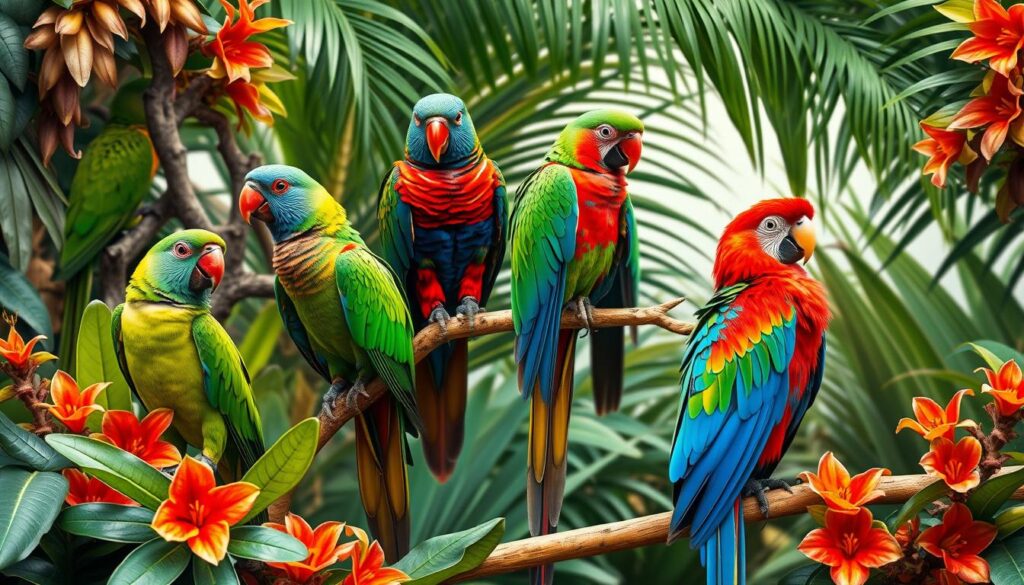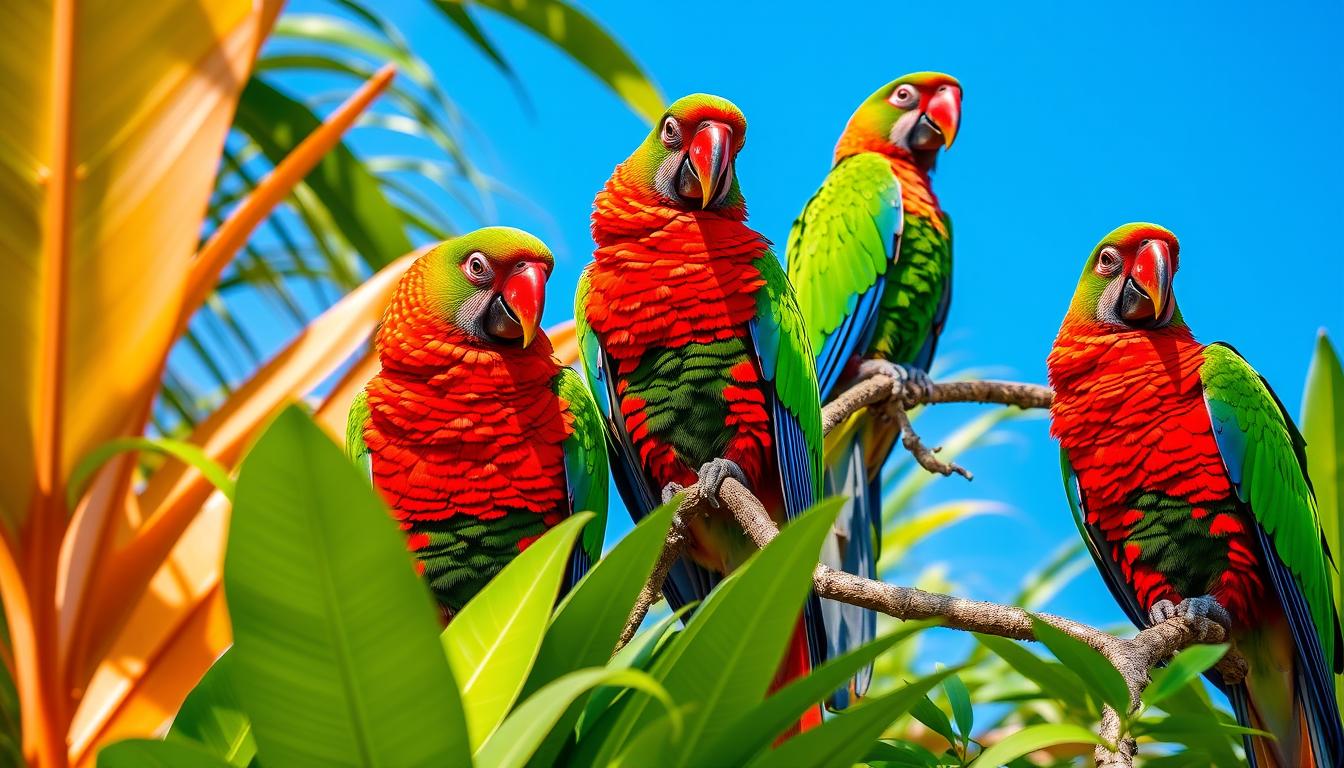The Beauty of Eclectus Parrots: Colors, Sizes, and Features
Looking at an Eclectus parrot, you can’t help but be amazed by their beauty. These parrots, found in Oceania’s rainforests, are truly stunning. Males have bright green feathers, while females show off red and purple.
Seeing their detailed patterns and bright colors is thrilling. Whether you love birds or just enjoy nature, Eclectus parrots will amaze you. Let’s explore their sizes, unique traits, and how they got their stunning looks.
Overview of Eclectus Parrots
Origin and Habitat
The Eclectus Roratus, or Eclectus parrot, comes from the rainforests of Oceania. It’s mainly found in New Guinea and Australia. These colorful parrots live in coastal areas, swamplands, and mangrove habitats.
They nest in tree hollows high up, at 14-22 meters. The genus Eclectus has four living species and one extinct one. These parrots are medium-sized, about 35-42 cm long.
They have a special trait called reverse sexual dichromatism. Males are mostly green, and females are mostly red or purple.
Behavior and Social Structure
Eclectus parrots are very social. They often travel and forage in groups or pairs. Their social structure is unique, with females having multiple male partners.
On the other hand, males can have multiple female partners. This is because of the limited nesting sites in their habitat. Males travel far to feed the females and chicks.

| Species | Adult Length | Adult Weight | Lifespan |
|---|---|---|---|
| Eclectus Parrot | 31-37 cm (12-14.5 in) | 375-500 g (13-19.5 oz) | Approximately 40 years |
Distinctive Colors of Eclectus Parrots
The Eclectus parrot is known for its striking differences in color between males and females. This color variation shows the beauty and diversity of parrot plumage.
Male vs. Female Colors
Male Eclectus parrots are a bright emerald green. They have red underwings and blue primary feathers. On the other hand, female Eclectus parrots have deep red and purple on their chest and abdomen. The rest of their body is a rich green.
This color difference has a purpose. The male’s color helps him blend in while foraging. The female’s color attracts mates and keeps other females away.
Seasonal Changes in Plumage
Unlike many parrots, Eclectus parrots don’t change color with the seasons. Their colors stay the same all year. This makes them easily recognizable.
The sexual dimorphism and parrot plumage of the Eclectus parrot make it stand out. It’s one of the most colorful parrots in the world, loved by birdwatchers and enthusiasts.

Sizes and Variations of Eclectus Parrots
Eclectus parrots are known for their size and weight. They are usually 14 to 15 inches long. Males grow larger than females.
Male Eclectus Parrots weigh between 17-21 ounces. Females are a bit lighter, weighing between 4.1 to 4.6 inches.
Different Species of Eclectus Parrots
The Eclectus parrot family has four unique species:
- Moluccan Eclectus
- Sumba Eclectus
- Tanimbar Eclectus
- Papuan Eclectus
The Papuan Eclectus has a subspecies, the Australian Eclectus. It is the largest, reaching up to 37 cm in length.
| Eclectus Species | Average Length |
|---|---|
| Moluccan Eclectus | 35-42 cm |
| Sumba Eclectus | 35-42 cm |
| Tanimbar Eclectus | 35-42 cm |
| Papuan Eclectus (including Australian Eclectus) | 35-42 cm |
Eclectus parrots are famous for their striking looks. Males have bright green feathers, while females have red and purple feathers. This makes them one of the most beautiful parrot species.

Physical Features That Stand Out
Eclectus parrots have unique physical traits that make them stand out. Their beaks and tails are especially noteworthy. Their feathers also have special structures.
Beak and Tail Characteristics
The Eclectus parrot’s beak is quite striking. Males have a light orange upper mandible and a black lower mandible. Females have all black mandibles. This difference in beak color shows the species’ clear sexual dimorphism.
Eclectus parrots also have short tails compared to other parrots. Their short tails help them move through dense tropical forests.
Unique Feather Structure
Eclectus parrots have feathers that look like silk. This special feather structure helps them blend in with their forest homes. Male Eclectus parrots have feathers that reflect UV light. This is seen by females but not by predators, helping in courtship while keeping camouflage.
These unique features of the Eclectus parrot make them visually stunning. They also play key roles in their survival and reproduction. This shows the amazing adaptations of these birds.
Personality Traits of Eclectus Parrots
Eclectus parrots are known for their unique personalities. They are calm and gentle, especially male Eclectus. These birds are smart and playful when they feel safe, enjoying time with their owners.
But, they can seem reserved or “lethargic” when stressed or in new places. This is a natural way for them to cope with threats. It’s key for owners to create a calm space for their Eclectus parrots.
Calm and Gentle Nature
One key trait of Eclectus parrots is their calm and gentle nature. Male Eclectus are especially known for this. They make great pets for those who want a peaceful and loving bird.
Intelligence and Playfulness
Eclectus parrots are very smart and can do complex things. They are playful when they feel safe, showing curiosity and joy. This makes them great pets for those who can give them the right care.
Knowing about Eclectus parrots’ personalities is important for owners. It helps create a happy and fulfilling relationship with these amazing birds. By understanding their calm, intelligence, and playfulness, you can give your Eclectus parrot the best care.
Care Requirements for Eclectus Parrots
Owning an Eclectus parrot means you must commit to their care. They need a special parrot diet and a big aviary. These birds have unique needs for their health and happiness.
Diet and Nutrition
Eclectus parrots love fruits and veggies. They need dark greens and orange foods to avoid Vitamin A deficiency. Their diet should be 80% fruits and veggies, with 20% seeds and nuts as treats.
Watch their weight since they can get fat. A healthy diet with less fat and calories is important for their health.
Habitat Needs
Eclectus parrots need big aviaries for flying. The aviary should be at least 3 meters long. It should look like their rainforest home with lots of perches and hiding spots.
They prefer temperatures of 65–75°F. Good air flow and humidity are also key for their comfort.
With the right Eclectus care, including a good diet and aviary, your parrot will be happy and healthy.
Socialization and Interaction
Eclectus parrots form strong bonds with their owners, especially if they’re hand-reared young. These smart birds do well with positive training, making them great friends for those who put in the effort.
Bonding with Your Eclectus Parrot
Creating a strong bond with your Eclectus parrot is key for their happiness and your joy. Males are often easier to socialize, but females need more patience and space. Regular interaction, handling, and mental games are essential for a loving relationship.
Handling and Training Techniques
Early handling and training make an Eclectus parrot well-adjusted and loving. Positive reinforcement, like treats or praise, is very effective. Start with small steps and be patient as your parrot learns to trust you. With effort, you can teach your Eclectus many tricks, deepening your connection.
Socializing an Eclectus parrot needs a gentle, steady approach. Regular interaction, positive training, and slow introduction to new things help build a lasting bond with your feathered friend.
“Eclectus parrots are intelligent, social birds that thrive on positive reinforcement and consistent interaction with their owners. By building a strong bond through socialization, you can create a truly rewarding and fulfilling relationship with your feathered friend.”
Health Considerations
Eclectus parrots are truly stunning, but their health is just as important. Getting them the right care and taking preventive steps is key. This ensures they stay healthy and happy in their homes. Let’s look at common health issues and how to keep them well.
Common Health Concerns
Eclectus parrots can face many health problems. These include Vitamin A deficiency, feather plucking, and respiratory infections. Vitamin A issues can affect their eyes, skin, and breathing. Feather plucking might show stress or boredom. And, respiratory infections can be deadly if not treated.
Preventive Health Care Tips
- Take your Eclectus parrot for regular vet visits. This helps catch health problems early.
- Feed them a balanced diet full of vitamins and minerals. This keeps them healthy.
- Keep their living space clean and well-ventilated. Give them lots of exercise and mental games to avoid boredom and stress.
- Watch their behavior and droppings closely. Any changes could mean a health issue.
By being careful and providing great care, your Eclectus parrot can live a long, happy life. Remember, regular vet visits are crucial for their health and happiness.
“Preventive medicine is the key to maintaining the health and well-being of pet birds. Regular check-ups and proactive care can make all the difference in their quality of life.”
Understanding Their Vocalization
Eclectus parrots are known for their wide range of sounds. They make everything from metallic clinks to soft chimes. They even mimic human speech, which is quite surprising.
Common Sounds and Their Meanings
The “aaarrr” call is a common sound from Eclectus parrots. It usually means they’re happy or curious. Loud screeches, however, might show they’re scared or excited.
These sounds help the parrots connect with each other. It’s not just about expressing feelings. It’s also about building relationships, whether with other birds or humans.
Training for Better Vocalization
Training can make Eclectus parrots use their sounds more wisely. By interacting with them regularly and keeping their environment interesting, you can improve their communication. This way, they can better express their needs and wants.
By doing this, you’ll strengthen your bond with your Eclectus parrot. It’s a great way to enhance your bird communication.
| Parrot Vocalization | Meaning |
|---|---|
| Chirping | Sign of a happy, content parrot |
| Squawking | Can signify a variety of feelings, from fear and annoyance to excitement |
| Screaming | May indicate the parrot is frightened, agitated, or seeking attention |
| Preening | Sign of a relaxed, comfortable bird |
| Feather fluffing | Could indicate contentment or, in some cases, illness |
The Role of Eclectus Parrots in Bird Conservation
Eclectus parrots are not yet endangered worldwide. However, their population is decreasing in some places. The Sumba eclectus, for example, is endangered with only 1,000 to 2,499 mature birds left. This shows how vital it is to protect these colorful birds and their homes.
Importance of Conservation Efforts
Eclectus parrots are key to their ecosystems. They help spread seeds, which helps their rainforest homes grow. But, deforestation and losing their habitats threaten their survival. Groups dedicated to conservation are working hard to save these parrots and their homes.
How You Can Help
You can help save Eclectus parrots in many ways. Supporting groups that protect their habitats and regulate the pet trade is a big help. Also, choosing products that don’t harm forests, like sustainable palm oil, can help. If you want an Eclectus parrot, get it from a trusted, ethical source to stop illegal trade.







